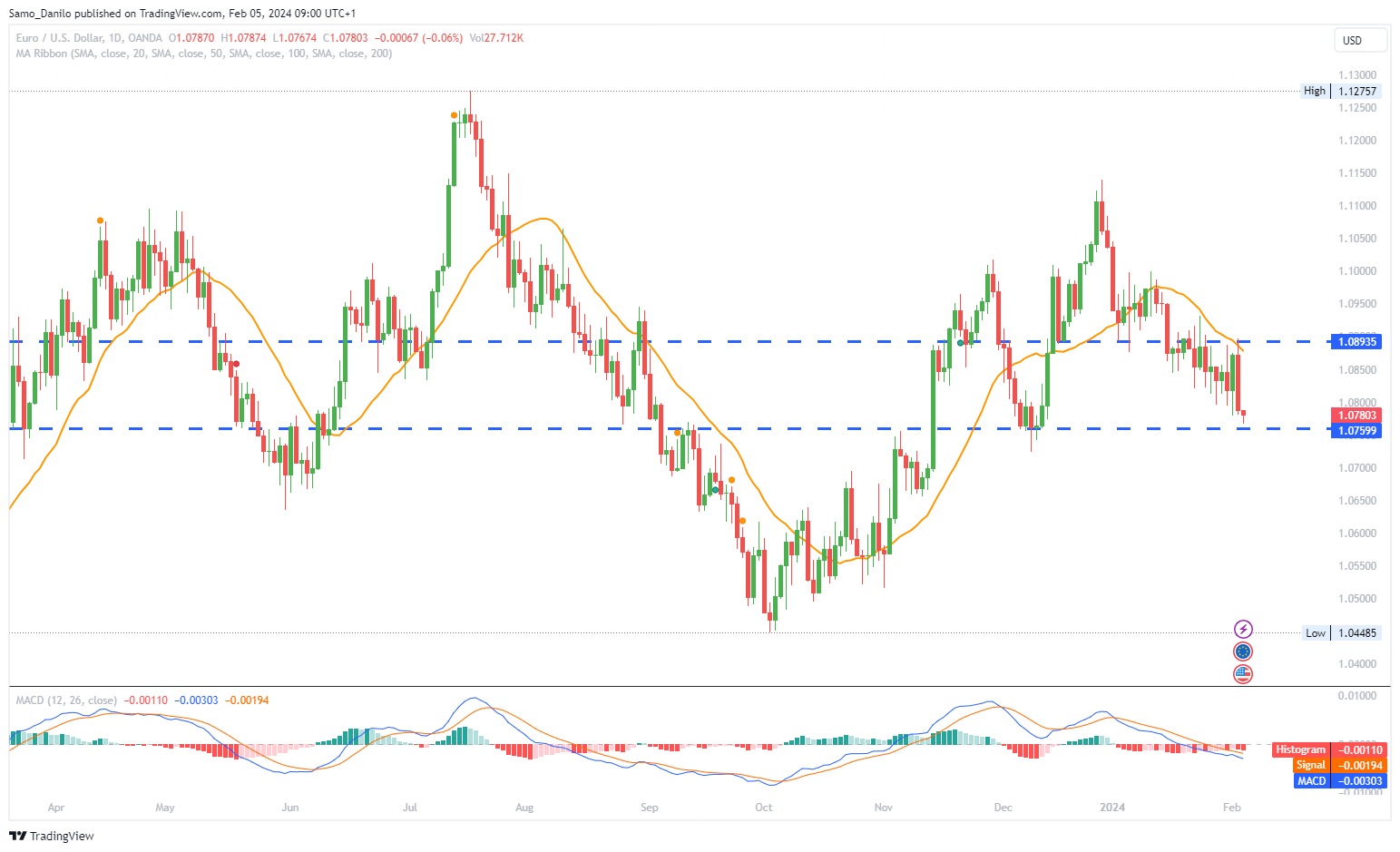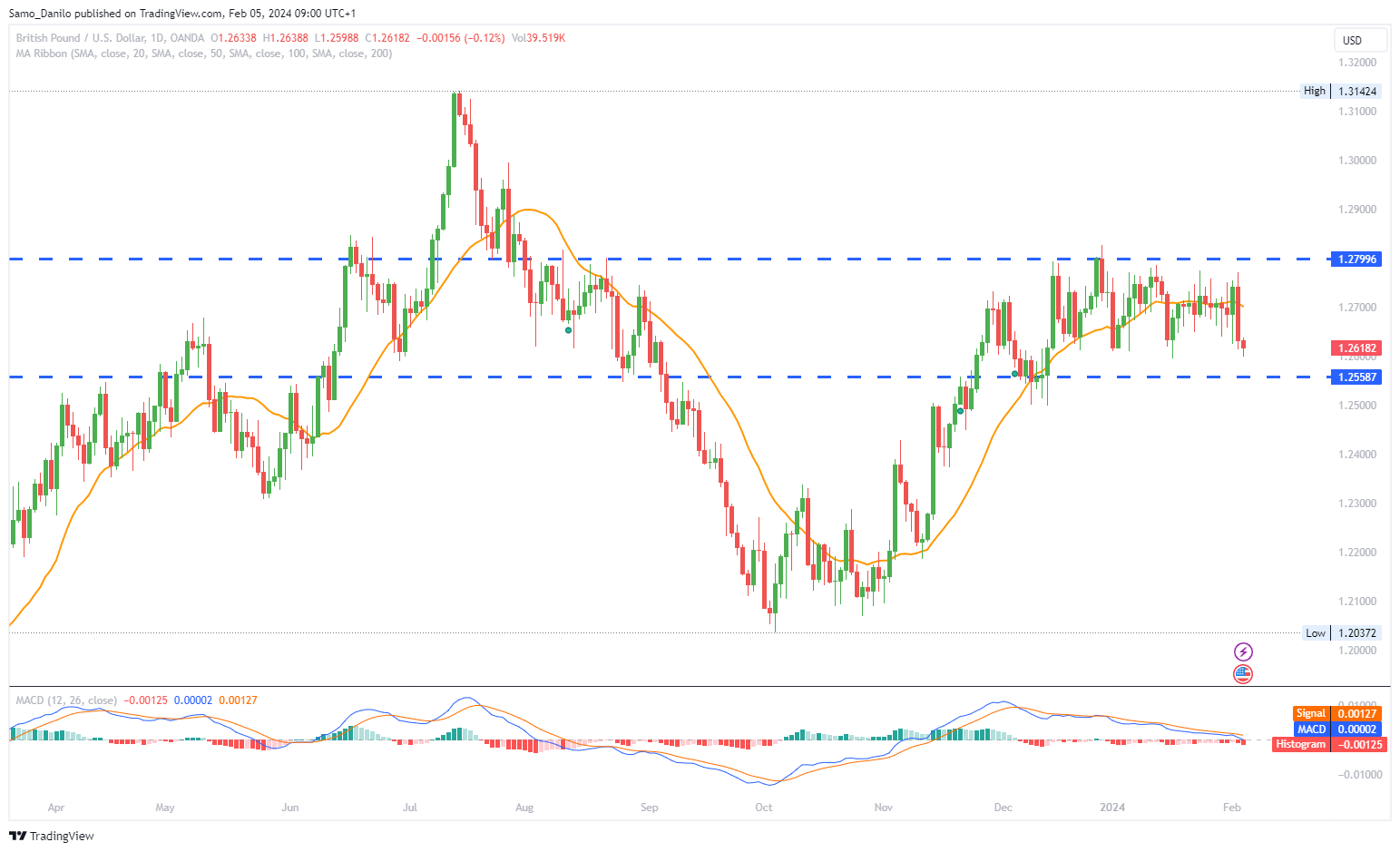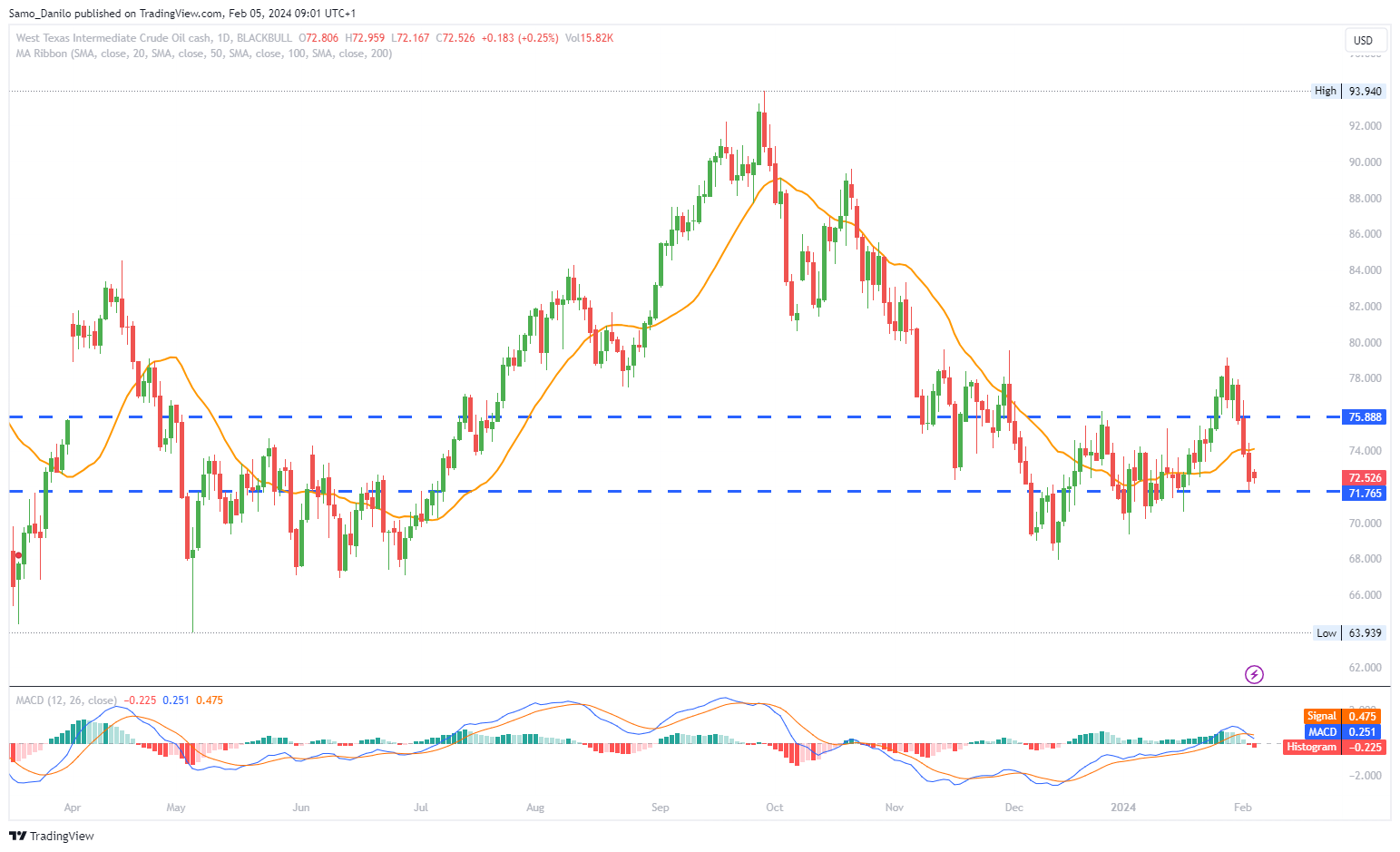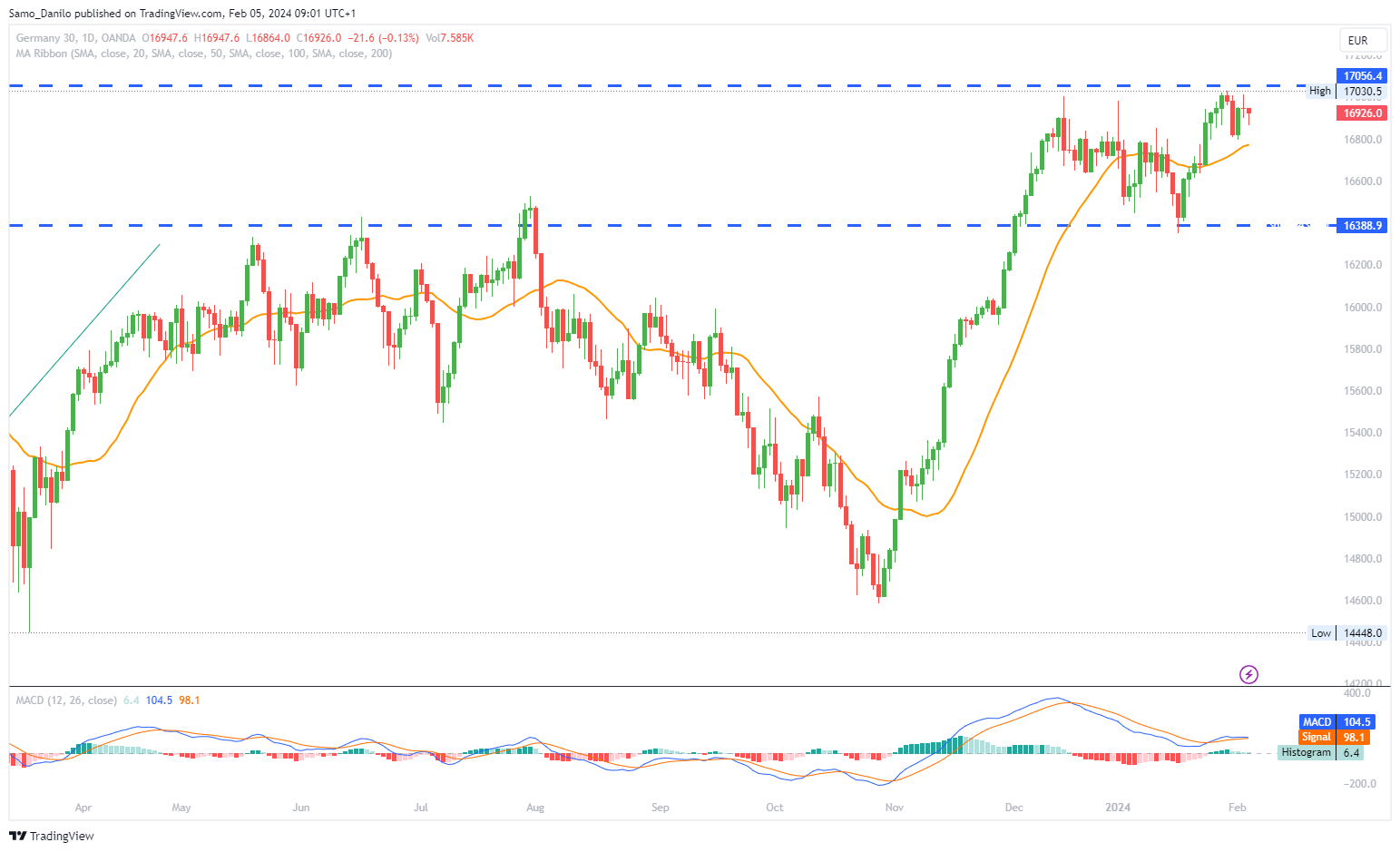EURUSD
- The EUR/USD pair is trading defensively below the 1.0800 level in the European session on Monday. This suggests a cautious or bearish sentiment for the Euro against the US Dollar.
- The US Dollar is holding gains, and this strength is attributed to comments from Fed Chair Jerome Powell. Powell indicated a reluctance to cut interest rates in the face of escalating geopolitical tensions in the Middle East. This suggests a less dovish stance by the Federal Reserve.
- The report mentions that on Friday, the Nonfarm Payrolls (NFP) for January exceeded expectations, rising by 353K compared to an expected increase of 185K. Strong job market data can bolster the US Dollar by suggesting economic resilience.
- Boris Vujcic, a member of the European Central Bank (ECB) Governing Council, emphasized the need for the ECB to ensure there are no second-round effects on inflation from wages before considering interest rate cuts. This suggests a cautious approach to monetary policy.
- Investors are advised to keep an eye on the January HCOB Composite PMI from Germany, the Eurozone, and Spain. Additionally, the ISM Services PMI from the United States is mentioned. These Purchasing Managers' Index (PMI) figures are key indicators of economic health and can impact currency movements.
Closing statement: The EUR/USD pair is under pressure, influenced by a stronger US Dollar, particularly in the context of robust US employment data. Comments from ECB officials and upcoming PMI data are expected to be monitored for further insights into the economic conditions affecting the Eurozone and the United States.
GBPUSD
- The GBP/USD pair is experiencing a decline for the second consecutive session, trading lower around 1.2610 during the Asian trading hours on Monday. This indicates a bearish trend for the British Pound against the US Dollar.
- Jerome Powell, Chair of the US Federal Reserve (Fed), repeated that the March meeting is likely too soon to have confidence in starting rate cuts. This suggests a cautious approach by the Fed regarding the timing of interest rate adjustments.
- Traders are expected to monitor economic indicators for insights into the state of the US labor market and potential implications for monetary policy. Specifically, the ISM Services Employment Index, scheduled for release on Monday, is mentioned as a key indicator to watch.
- Andrew Bailey, the Governor of the Bank of England (BoE), avoided speculation on rate cuts and warned that price pressures could pick up again in the second half of the year. This suggests a more cautious stance by the BoE, with a focus on potential inflationary pressures.
- Huw Pill, the Chief Economist of the Bank of England (BoE), mentioned that the right time for the BoE to cut interest rates is probably still some time away. This indicates a reluctance to consider rate cuts in the near term.
| SMA (20) | Neutral | |
| RSI (14) | Slightly Falling |
|
| MACD (12, 26, 9) | Slightly Falling |
|
Closing statement: GBP/USD is on a downward trend, influenced by cautious comments from Fed Chair Powell and the BoE Governor regarding the timing of rate cuts. Traders are closely watching economic indicators for insights into the US labour market, and the Bank of England appears to be adopting a wait-and-see approach to monetary policy.
GOLD
- Gold is experiencing selling pressure for the second consecutive day on Monday, trading around the $2,030 area. The price is down nearly 0.30% for the day, indicating a decline in the value of gold.
- The selling pressure on gold is attributed to the dialing back of expectations for Fed rate cuts this year. Fed Chair Jerome Powell, in an interview aired early Monday, dismissed the possibility of a rate cut next month and pushed back against the timing of rate cuts. This has influenced market expectations for the Fed's monetary policy.
- The current market positioning suggests an 85% probability that the Fed will keep interest rates unchanged next month. For May, the odds of a rate cut stand at about 65%. This indicates a shift in expectations regarding the timing of potential rate adjustments.
- Despite the challenges facing gold, such as reduced expectations of rate cuts, the traditional safe-haven asset could still find support from escalating geopolitical tensions between the West and the Middle East. Gold tends to be sought after as a safe-haven investment during times of geopolitical uncertainty.
- Traders are anticipated to look forward to the ISM Services PMI and S&P Global final Services PMI data for fresh trading impetus on gold price. Economic data releases can impact market sentiment and influence the direction of gold prices.
| SMA (20) | Slightly Falling |
|
| RSI (14) | Slightly Falling |
|
| MACD (12, 26, 9) | Slightly Rising |
|
Closing statement: Gold is facing selling pressure due to a re-evaluation of expectations for Fed rate cuts, but its status as a safe-haven asset may still provide support amid geopolitical tensions. Traders are closely monitoring economic data for potential market-moving information.
CRUDE OIL
- West Texas Intermediate (WTI) oil prices are facing challenges in breaking a three-day losing streak on Monday. This suggests a recent trend of declining prices in the oil market.
- Despite heightened geopolitical tensions in the Middle East, with the US and the UK conducting air strikes on the Iran-backed Houthi militant group in Yemen, crude oil prices have not sustained their intraday gains. Geopolitical events often have a significant impact on oil prices due to concerns about potential disruptions to the global oil supply.
- The recent blockbuster job data from the United States has played a role in diminishing the likelihood of interest rate cuts by the Federal Reserve in March. Changes in interest rates can influence the value of the US dollar and, subsequently, commodity prices, including oil.
- The Organization of the Petroleum Exporting Countries and its allies (OPEC+) are expected to face a long-term challenge in 2024 and 2025. This challenge is related to OPEC+ efforts to reduce global oil supply by implementing strict production quotas on member nations.
- There are concerns that non-OPEC producers, including the United States, could potentially outstrip the OPEC+ supply cuts, leading to an oversupply in global markets. Oversupply can put downward pressure on oil prices.
| SMA (20) | Slightly Rising |
|
| RSI (14) | Slightly Falling |
|
| MACD (12, 26, 9) | Slightly Falling |
|
Closing statement: In summary, the information highlights the struggles of WTI oil prices, the nuanced impact of geopolitical tensions, the influence of US job data on market expectations, and the long-term challenges faced by OPEC+ in managing global oil supply. Additionally, concerns about potential oversupply contribute to the complex dynamics of the oil market.
DAX
- The DAX index achieved a significant milestone by hitting a fresh record high of 17,005 last week. This indicates a positive trend and strong performance in the German stock market.
- Germany's trade surplus, when adjusted for calendar and seasonal factors, stood at €22.2 billion in December. This figure represents an increase from the previous month's surplus of €20.4 billion. The trade surplus is an important economic indicator reflecting the balance of trade for a country.
- On Monday, investors are advised to consider the Purchasing Managers' Index (PMI) numbers for the service sector in both Germany and the Eurozone. PMI is a leading economic indicator that provides insights into the health of the services sector.
- Additionally, on the same day, the focus will be on the US ISM Non-Manufacturing PMI. This data point is important for gauging the health of the non-manufacturing sector in the United States. A better-than-expected ISM Non-Manufacturing PMI could influence market sentiment and impact expectations regarding a March Fed rate cut.
- Beyond the economic calendar, investors are also encouraged to consider corporate earnings from Germany and Europe. Earnings reports can have a significant impact on the stock market, influencing investor sentiment and stock prices.
| SMA (20) | Slightly Rising |
|
| RSI (14) | Slightly Falling |
|
| MACD (12, 26, 9) | Slightly Rising |
|
Closing statement: The DAX has reached a record high, and economic indicators, along with corporate earnings, are key factors for investors to watch. The trade surplus and PMI numbers provide insights into economic conditions, and the US ISM Non-Manufacturing PMI is a crucial event for global market sentiment.




